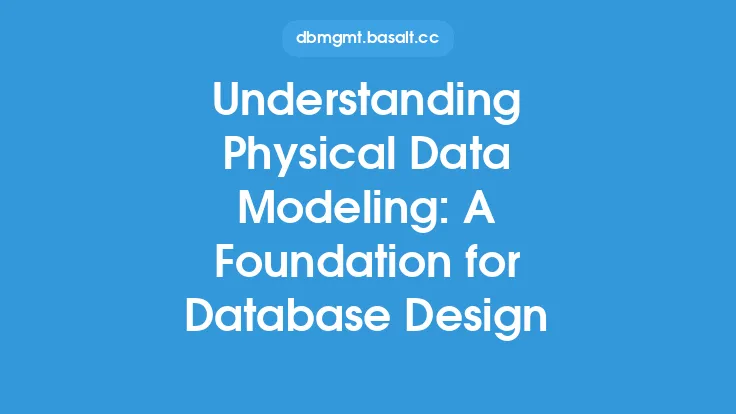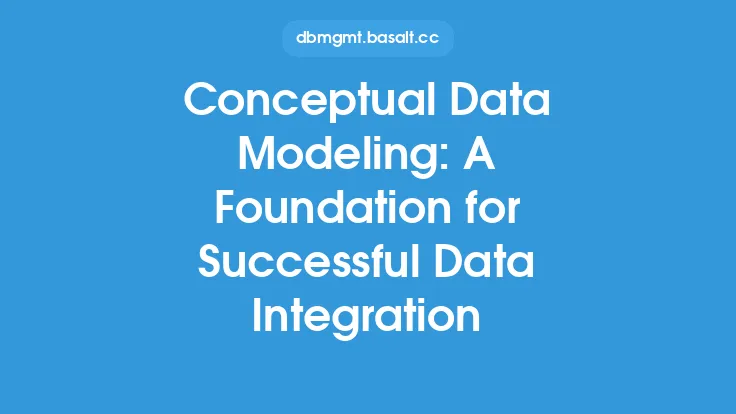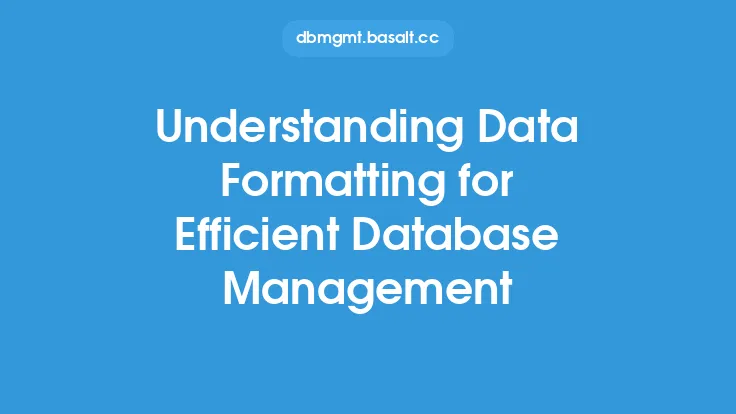Data modeling is a crucial aspect of data management, as it enables organizations to create a conceptual representation of their data assets. This representation is essential for efficient data management, as it provides a common understanding of the data and its relationships. Data modeling standards play a vital role in ensuring that data models are consistent, accurate, and reusable. In this article, we will delve into the world of data modeling standards, exploring their importance, benefits, and best practices.
Introduction to Data Modeling Standards
Data modeling standards are a set of guidelines and rules that govern the creation, maintenance, and use of data models. These standards ensure that data models are developed consistently, using a common language and notation. This consistency is essential for efficient data management, as it enables organizations to integrate data from different sources, reduce data redundancy, and improve data quality. Data modeling standards also facilitate communication among stakeholders, including data architects, developers, and business users, by providing a common understanding of the data and its relationships.
Benefits of Data Modeling Standards
The benefits of data modeling standards are numerous. Firstly, they enable organizations to create a unified view of their data assets, which is essential for efficient data management. This unified view enables organizations to identify data redundancy, improve data quality, and reduce data inconsistencies. Secondly, data modeling standards facilitate data integration, which is critical for organizations that need to combine data from different sources. By using a common data model, organizations can integrate data from different systems, reducing the complexity and cost associated with data integration. Finally, data modeling standards improve communication among stakeholders, reducing misunderstandings and errors that can occur when different stakeholders have different interpretations of the data.
Components of Data Modeling Standards
Data modeling standards consist of several components, including notation, terminology, and rules. Notation refers to the symbols and diagrams used to represent data entities, attributes, and relationships. Terminology refers to the language used to describe data entities, attributes, and relationships. Rules refer to the guidelines that govern the creation and maintenance of data models. These components work together to ensure that data models are consistent, accurate, and reusable.
Notation Standards
Notation standards are a critical component of data modeling standards. Notation standards define the symbols and diagrams used to represent data entities, attributes, and relationships. There are several notation standards available, including Entity-Relationship Diagrams (ERDs), Object-Role Modeling (ORM), and Unified Modeling Language (UML). ERDs are a popular notation standard, as they provide a simple and intuitive way to represent data entities, attributes, and relationships. ORM is another popular notation standard, as it provides a more detailed and formal way to represent data entities, attributes, and relationships. UML is a widely used notation standard, as it provides a comprehensive and flexible way to represent data entities, attributes, and relationships.
Terminology Standards
Terminology standards are another critical component of data modeling standards. Terminology standards define the language used to describe data entities, attributes, and relationships. Terminology standards ensure that data models are consistent and unambiguous, reducing misunderstandings and errors that can occur when different stakeholders have different interpretations of the data. There are several terminology standards available, including the ISO/IEC 11179 standard, which provides a comprehensive and widely accepted terminology standard for data modeling.
Rules and Guidelines
Rules and guidelines are essential components of data modeling standards. Rules and guidelines govern the creation and maintenance of data models, ensuring that they are consistent, accurate, and reusable. Rules and guidelines define the best practices for data modeling, including the use of notation, terminology, and data modeling techniques. There are several rules and guidelines available, including the Data Management Body of Knowledge (DMBOK), which provides a comprehensive and widely accepted set of rules and guidelines for data management.
Best Practices for Implementing Data Modeling Standards
Implementing data modeling standards requires careful planning and execution. The first step is to establish a data modeling team, which is responsible for developing and maintaining the data modeling standards. The second step is to define the scope and objectives of the data modeling standards, including the notation, terminology, and rules to be used. The third step is to develop a data modeling methodology, which defines the steps and techniques to be used for data modeling. The fourth step is to train stakeholders on the data modeling standards, ensuring that they understand the notation, terminology, and rules. Finally, the fifth step is to monitor and maintain the data modeling standards, ensuring that they remain relevant and effective.
Challenges and Limitations of Data Modeling Standards
While data modeling standards offer numerous benefits, there are also challenges and limitations to consider. One of the main challenges is the complexity of data modeling standards, which can make them difficult to understand and implement. Another challenge is the cost of implementing data modeling standards, which can be significant, especially for large and complex organizations. Finally, there is the risk of data modeling standards becoming outdated, which can reduce their effectiveness and relevance.
Conclusion
In conclusion, data modeling standards are a critical component of efficient data management. They provide a common understanding of the data and its relationships, enabling organizations to integrate data from different sources, reduce data redundancy, and improve data quality. By understanding the components of data modeling standards, including notation, terminology, and rules, organizations can develop and implement effective data modeling standards. By following best practices for implementing data modeling standards, organizations can ensure that their data modeling standards are effective and relevant. While there are challenges and limitations to consider, the benefits of data modeling standards make them an essential investment for any organization that wants to manage its data assets efficiently and effectively.





